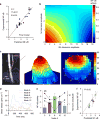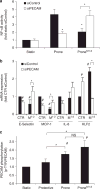Human haemodynamic frequency harmonics regulate the inflammatory phenotype of vascular endothelial cells
- PMID: 23443553
- PMCID: PMC4100071
- DOI: 10.1038/ncomms2530
Human haemodynamic frequency harmonics regulate the inflammatory phenotype of vascular endothelial cells
Abstract
Haemodynamic variations are inherent to blood vessel geometries (such as bifurcations) and correlate with regional development of inflammation and atherosclerosis. However, the complex frequency spectrum characteristics from these haemodynamics have never been exploited to test whether frequency variations are critical determinants of endothelial inflammatory phenotype. Here we utilize an experimental Fourier transform analysis to systematically manipulate individual frequency harmonics from human carotid shear stress waveforms applied in vitro to human endothelial cells. The frequency spectrum, specifically the 0 th and 1st harmonics, is a significant regulator of inflammation, including NF-κB activity and downstream inflammatory phenotype. Further, a harmonic-based regression-model predicts eccentric NF-κB activity observed in the human internal carotid artery. Finally, short interfering RNA-knockdown of the mechanosensor PECAM-1 reverses frequency-dependent regulation of NF-κB activity. Thus, PECAM-1 may have a critical role in the endothelium's exquisite sensitivity to complex shear stress frequency harmonics and provide a mechanism for the focal development of vascular inflammation.
Conflict of interest statement
Figures







Similar articles
-
Atheroprone hemodynamics regulate fibronectin deposition to create positive feedback that sustains endothelial inflammation.Circ Res. 2010 Jun 11;106(11):1703-11. doi: 10.1161/CIRCRESAHA.109.216283. Epub 2010 Apr 8. Circ Res. 2010. PMID: 20378855 Free PMC article.
-
Haemodynamic stress-induced breaches of the arterial intima trigger inflammation and drive atherogenesis.Eur Heart J. 2019 Mar 14;40(11):928-937. doi: 10.1093/eurheartj/ehy822. Eur Heart J. 2019. PMID: 30541066
-
Focal TLR4 activation mediates disturbed flow-induced endothelial inflammation.Cardiovasc Res. 2020 Jan 1;116(1):226-236. doi: 10.1093/cvr/cvz046. Cardiovasc Res. 2020. PMID: 30785200
-
The atherosusceptible endothelium: endothelial phenotypes in complex haemodynamic shear stress regions in vivo.Cardiovasc Res. 2013 Jul 15;99(2):315-27. doi: 10.1093/cvr/cvt101. Epub 2013 Apr 25. Cardiovasc Res. 2013. PMID: 23619421 Free PMC article. Review.
-
Mechanosensitive microRNAs-role in endothelial responses to shear stress and redox state.Free Radic Biol Med. 2013 Sep;64:61-8. doi: 10.1016/j.freeradbiomed.2013.05.034. Epub 2013 May 30. Free Radic Biol Med. 2013. PMID: 23727269 Free PMC article. Review.
Cited by
-
Caveolae: A Role in Endothelial Inflammation and Mechanotransduction?Front Physiol. 2016 Dec 20;7:628. doi: 10.3389/fphys.2016.00628. eCollection 2016. Front Physiol. 2016. PMID: 28066261 Free PMC article. Review.
-
Fluid Shear Stress-Regulated Vascular Remodeling: Past, Present, and Future.Arterioscler Thromb Vasc Biol. 2025 Jun;45(6):882-900. doi: 10.1161/ATVBAHA.125.322557. Epub 2025 Apr 10. Arterioscler Thromb Vasc Biol. 2025. PMID: 40207366 Review.
-
Estimation of Diabetic Retinal Microaneurysm Perfusion Parameters Based on Computational Fluid Dynamics Modeling of Adaptive Optics Scanning Laser Ophthalmoscopy.Front Physiol. 2018 Sep 7;9:989. doi: 10.3389/fphys.2018.00989. eCollection 2018. Front Physiol. 2018. PMID: 30245632 Free PMC article.
-
Vibro-Acoustic Platelet Activation: An Additive Mechanism of Prothrombosis with Applicability to Snoring and Obstructive Sleep Apnea.Bioengineering (Basel). 2023 Dec 12;10(12):1414. doi: 10.3390/bioengineering10121414. Bioengineering (Basel). 2023. PMID: 38136005 Free PMC article.
-
Hybrid System for Ex Vivo Hemorheological and Hemodynamic Analysis: A Feasibility Study.Sci Rep. 2015 Jun 19;5:11064. doi: 10.1038/srep11064. Sci Rep. 2015. PMID: 26090816 Free PMC article.
References
-
- Ku DN, Giddens DP, Zarins CK, Glagov S. Pulsatile flow and atherosclerosis in the human carotid bifurcation. Positive correlation between plaque location and low oscillating shear stress. Arteriosclerosis. 1985;5:293–302. - PubMed
Publication types
MeSH terms
Substances
Grants and funding
LinkOut - more resources
Full Text Sources
Other Literature Sources
Miscellaneous

